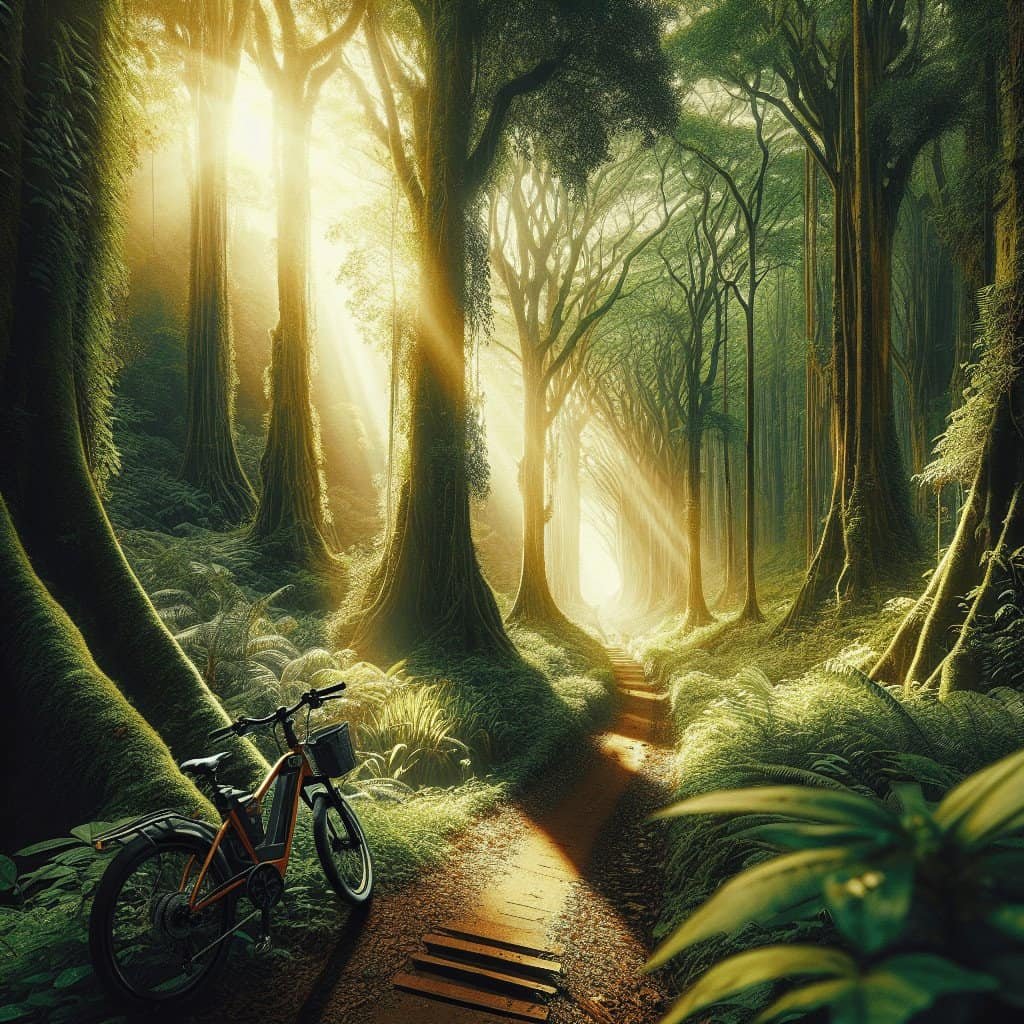Imagine a sunny weekend morning, as you embark on an outdoor adventure, the wind gently brushing against your face as you cycle along a scenic trail. The question arises, can you hop on an electric bike and explore the serene beauty of a nature reserve? Well, the answer is not so straightforward. While some nature reserves do permit electric bikes on their public trails, others have imposed restrictions, calling for a deeper understanding of the regulations in place. So, before you embark on your next journey, let’s unravel the intricate web of guidelines surrounding the use of electric bikes in nature reserves.
Understanding Electric Bikes and Nature Reserves
Defining Electric Bikes
Electric bikes, also known as e-bikes, are bicycles that are equipped with an integrated electric motor. These motors provide an additional boost to the rider’s pedaling power, making it easier to navigate hills and longer distances. E-bikes come in various styles, including mountain bikes, hybrids, and cruisers, catering to different riding preferences and terrains. With their rising popularity, it is important to understand the implications of riding e-bikes in nature reserves.
Exploring Nature Reserves
Nature reserves are protected areas that are specifically designated to conserve and preserve biodiversity. These natural habitats are home to a wide range of plant and animal species, making them crucial for ecological balance and research purposes. Nature reserves often feature a network of hiking trails and designated bike paths, providing an ideal environment for outdoor enthusiasts to explore and appreciate nature’s beauty.
Regulations and Policies
Local Laws and Regulations
Before taking your e-bike to a nature reserve, it is important to familiarize yourself with the local laws and regulations governing electric bike usage. Laws may vary from one reserve to another, so it is essential to check with the respective authorities or visitor centers for specific guidelines on e-bike usage. Some reserves may have restrictions on motorized vehicles on their trails, while others may have specific policies in place to accommodate e-bikes.
Nature Reserve Policies
Nature reserves often have their own set of policies regarding biking, which may include specific regulations for e-bikes. These policies aim to strike a balance between recreational activities and environmental conservation. Some reserves may permit e-bike usage on designated trails, while others may restrict usage to certain areas or impose speed limitations. It is crucial to adhere to these policies to ensure the protection of wildlife and habitats.

Types of Trails
Designated Bike Trails
Many nature reserves have dedicated bike trails that are specifically designed and maintained for cyclists. These trails provide a safe and enjoyable experience for riders, separate from pedestrian traffic. Designated bike trails often have varying levels of difficulty, catering to both beginners and experienced cyclists. When riding an e-bike on these trails, it is important to stay on the designated path and be mindful of other users.
Multi-Use Trails
In addition to designated bike trails, some nature reserves have multi-use trails that allow for a variety of activities, including hiking, horseback riding, and cycling. These trails are shared spaces where users must exercise caution and respect for one another. If e-bike usage is permitted on multi-use trails, it is important to yield to pedestrians and other non-motorized trail users, maintaining a safe speed and avoiding unnecessary disturbances.
Environmental Impact
Considerations for Wildlife
When riding an e-bike in a nature reserve, it is crucial to consider the potential impact on wildlife. E-bikes, although quieter compared to traditional motorcycles, still produce some noise that may startle or disturb animals. When approaching wildlife, it is recommended to slow down, maintain a safe distance, and avoid rapid movements. By being mindful of wildlife, we can protect their natural behaviors and contribute to their overall well-being.
Erosion and Soil Impact
The increased speed and weight of e-bikes can potentially contribute to soil erosion on trails. This impact can be more significant on softer soils or steep slopes. To minimize soil erosion, it is important to stay on designated trails and avoid riding during wet or muddy conditions. By practicing responsible trail usage, we can ensure the long-term sustainability of these natural habitats.

Trail User Safety
Shared Trail Etiquette
When riding an e-bike on shared trails, it is essential to follow proper trail etiquette to ensure the safety and enjoyment of all users. This includes yielding to pedestrians, utilizing appropriate signaling and warning devices, and keeping a safe distance from other trail users. Being courteous and respectful to fellow outdoor enthusiasts creates a positive and harmonious experience for everyone.
Speed Limitations
Some nature reserves may have specific speed limitations for e-bikes to prevent accidents and maintain trail safety. It is important to adhere to these speed limits and adjust your riding speed accordingly. Riding at a safe and controlled speed allows for better maneuverability and reduces the risk of collisions with other users or wildlife.
Noise and Disturbance
Effects on Wildlife
Wildlife in nature reserves are accustomed to the natural sounds of their surroundings. The noise generated by e-bikes can disrupt their behavior and potentially cause stress or avoidance responses. By keeping the noise level to a minimum and reducing sudden acceleration, we can minimize the disturbance to wildlife and allow them to carry out their natural activities undisturbed.
Disturbing Other Visitors
In addition to wildlife, e-bikes may also cause disturbance to other visitors in nature reserves. The quiet and serene atmosphere that draws many people to these reserves can be disrupted by the noise and speed of e-bikes. It is important to be considerate while riding, reducing unnecessary noise and slowing down when approaching other visitors. Respecting the serenity of these natural spaces ensures that everyone can appreciate and enjoy their time in the reserve.

Access and Trail Permits
Permit Requirements
Some nature reserves may require permits for access to certain areas or usage of specific trails. These permits often help manage visitor capacity, protect sensitive areas, and regulate recreational activities. Depending on the reserve, e-bike riders may need to obtain additional permits to ride on designated trails. It is important to inquire about permit requirements and obtain the necessary documentation before embarking on your e-bike adventure.
Obtaining Trail Permits
Trail permits can typically be obtained through the reserve’s visitor center or online platforms. The process may involve providing basic personal information, acknowledging the reserve’s rules and regulations, and paying a nominal fee, if applicable. By obtaining the required trail permits, you can ensure compliance with reserve policies and contribute to the preservation of these unique natural environments.
Monitoring and Enforcement
Ranger Patrols
Nature reserves often have ranger patrols that monitor visitors’ compliance with rules and regulations. These dedicated individuals are responsible for ensuring the safety of visitors, the protection of wildlife, and the preservation of the reserve’s natural resources. By cooperating with rangers, reporting any violations, and following their guidance, you can contribute to the overall management and enforcement efforts within the reserve.
Trail Cameras
To supplement ranger patrols, some nature reserves employ trail cameras for monitoring activities within the reserve. These cameras capture images and videos of trail users, helping monitor potential violations and gather data on visitor patterns. The presence of trail cameras serves as a visual reminder of the importance of responsible trail usage and encourages visitors to adhere to established regulations.

Alternative Transportation for Nature Reserves
Walking and Hiking
One of the most traditional and environmentally-friendly ways to explore nature reserves is on foot. Walking and hiking allow for a closer connection with the surroundings, enabling a deeper appreciation of the natural beauty and biodiversity. By opting for these non-motorized forms of transportation, you can reduce environmental impact and immerse yourself in the sights and sounds of the reserve.
Traditional Bicycles
Traditional bicycles remain a popular mode of transportation in nature reserves. These human-powered vehicles offer a sustainable and enjoyable way to navigate the trails, while also providing ample exercise opportunities. Traditional bicycles can be an excellent option for those who prefer a more physically demanding experience and wish to minimize their reliance on motorized assistance.
Advances in Electric Bike Technology
Quieter Motor Systems
As electric bike technology continues to evolve, manufacturers are working towards quieter motor systems. These advancements are aimed at reducing noise levels emitted by e-bikes, ensuring a more seamless integration into natural environments. Quieter motor systems help minimize disturbances to wildlife and allow riders to enjoy a quieter and more serene biking experience.
Eco-Friendly Battery Options
Battery technology used in e-bikes is also advancing towards more environmentally-friendly options. Lithium-ion batteries, commonly used in electric bikes, are becoming more efficient and recyclable. Additionally, emerging technologies are exploring alternative battery chemistries, including more sustainable and eco-friendly materials. By prioritizing eco-friendly battery options, e-bike riders can further minimize their environmental impact on nature reserves.
In conclusion, understanding the implications of riding electric bikes in nature reserves is essential to ensure a harmonious coexistence between recreational activities and environmental conservation. By adhering to local laws and regulations, practicing responsible trail usage, considering the impact on wildlife and habitats, and obtaining necessary permits, riders can enjoy the beauty of nature reserves while minimizing their ecological footprint. Embracing alternative transportation options such as walking, hiking, and traditional bicycles, as well as keeping up with advances in e-bike technology, offers opportunities to explore nature in a sustainable and responsible manner. Remember, by protecting and respecting nature reserves, we can ensure their preservation for generations to come.


